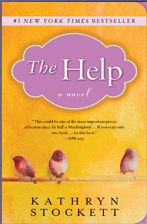The Help:
Let’s celebrate both movie and book

Let’s toast The Help and author Kathryn Stockett’s success. OK . . . now let’s drink to Skeeter, Aibileen, Minny, Celia and the whole cast of the movie for bringing Kathryn’s creations visually to life. As a chaser, let’s down a grand old sherry for all these winners, both on the bookshelves and the big screen. Here’s why:
- As a movie, The Help pulled in a boatload of trophies from film festivals and critics associations, including Golden Globe and Screen Actors Guild, and four Oscar nominations.
- The movie earned $205 million (as of February 5) on an investment of $25 million. Not a bad return; we’d take those winnings here in Las Vegas.
- The book has sold more than 5 million copies. It spent 100 weeks on the New York Times bestseller’s list. This was Kathryn Stockett’s first novel! What a phenom, the kind of success most of us writers only dream about.
We should all celebrate The Help. Here’s why:
- It plunges us into a slice of Black life in Jackson, Mississippi, 1962 to early ’64. Those were ugly times for Black Americans . . . especially in the segregated South.
- It reminds us why we needed the Civil Rights Movement: segregation, exploitation, the daily struggle of Blacks eking out a living in the face of daily denigration and racism.
- It focuses on women long ignored: maids trying to do their jobs –- not Civil Rights leaders or movement gurus . . . simply decent women trying to survive.
- It takes an implausible protagonist –- a young white woman, a local, who risks her standing to tell the story of maids in Jackson –- and tells their stories both through her eyes and theirs.
- By only hinting at the Civil Rights Movement swirling around them, the story focuses the reader (and viewer) on the daily lives of its characters . . . and forces us to draw on –- or develop -- our own Civil Rights context for their individual struggles.
Key Civil Rights events took place in the years covered in The Help. They pass by fleetingly in both the book and the movie: the Freedom Riders in 1961; and a host of events in 1963 -- the spring Children’s Crusade in Birmingham, Medgar Evers’ murder on June 11, MLK and the March on Washington on Aug. 28, the murder of the four girls at 16th Street Baptist in Birmingham on Sept. 15, JFK’s assassination on Nov. 22.
Kathryn Stockett easily could have wandered down any of those paths. By choosing not to, she has honed a story of people we care about . . . and we get a Civil Rights story previously untold, but cast in a larger context that readers themselves must bring to the story.
Those are some of the reasons I like The Help. But I also have a dark little secret: I’m in love with Kathryn Stockett. We’re kindred souls. She’s white, and she dares not only to write about Blacks, but to write a number of chapters from the viewpoints of Black maids. Whew, how some critics have howled about that!
In my novel, Soda Springs: Love, Sex, and Civil Rights, I write about an even lesser known Civil Rights Movement of the Sixties –- the beginnings of a Mexican-American struggle for justice in Soda Springs, Colorado. I’m white, too, (or Anglo, as we say in Colorado) not Mexican-American. I, too, have chapters written from the viewpoint of Mexican-American characters.
We had no other choice; we tell more rounded stories that way.
Good for you, Kathryn: let the narrow-minded critics rave on.
Read our The Help blog on Medgar Evers
Read our The Help blog on maids and women
Read more on Civil Rights in 1963
Read more on Civil Rights issues today
Return to home page
Enjoy this page? Please pay it forward. Here's how...
Would you prefer to share this page with others by linking to it?
- Click on the HTML link code below.
- Copy and paste it, adding a note of your own, into your blog, a Web page, forums, a blog comment,
your Facebook account, or anywhere that someone would find this page valuable.